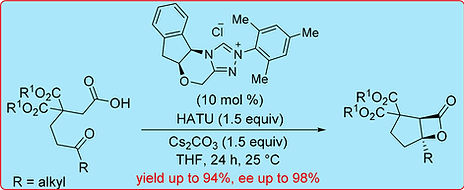

Publications

Das, T. K. *; Ghosh, A.; Grimm, Z.; Aguinaga,U.; Yousufuddin, M.; Kürti, L. Organocatalytic Electrophilic Arene Amination: RapidSynthesis of 2-Quinolones, Chem. Eur. J. 2025, 31, e202403524. (Highlighted in Synfacts 2025; 21(04): 346)
ChemRxiv (preprint) DOI: 10.26434/chemrxiv-2024-5902g
A fresh approach to 2-quinolone synthesis! This study presents an innovative organocatalytic electrophilic arene amination strategy, enabling the efficient synthesis of a diverse array of 2-quinolones – a critical scaffold with extensive industrial applications. By circumventing traditional metal-based catalysts, this approach paves the way for advancements in multiple sectors, offering a sustainable and versatile alternative.

Das, T. K.; Rodriguez-Treviño, A. M.; Pandiri, S.; Irvankoski, S.; Siitonen, J.; Rodriguez, S.M.; Yousufuddin, M.; Kürti, L. Catalyst-Free Transfer Hydrogenation of Activated Alkenes Exploiting Isopropanol as the Sole and Traceless Reductant, Green Chem., 2023, 25, 746-754.
ChemRxiv (preprint) DOI: 10.26434/chemrxiv-2022-k7wdb
Both metal-catalyzed and organocatalytic transfer hydrogenation reactions are widely employed for the reduction of C=O and C=N bonds. However, selective transfer hydrogenation reactions of C=C bonds remain challenging. Therefore, the chemoselective transfer hydrogenation of olefins under mild conditions and in the absence of metal catalysts, using readily available and inexpensive reducing agents (i.e. primary and secondary alcohols), will mark a significant advancement towards the development of green transfer hydrogenation strategies. Described herein is an unconventional catalyst-free transfer hydrogenation reaction of activated alkenes using isopropanol as an eco-friendly reductant and solvent.

Kattamuri, P. V.; Zhao, J.; Das, T. K.; Siitonen, J. H.; Morgan, N.; Ess, D. H.; Kürti, L. Aza-Quasi-Favorskii Reaction: Construction of Highly Substituted Aziridines through a Concerted Multi-bond Rearrangement Process.
J. Am. Chem. Soc., 2022, 144, 24, 10943–10949. doi.org/10.1021/jacs.2c03805 (Highlighted in Chemistry Views)
A new molecular rearrangement, the aza-Quasi-Favorskii rearrangement, has been developed for the construction of highly substituted aziridines. Electron-deficient O-sulfonyl oximes react readily with α,α-disubstituted acetophenone-derived enolates to furnish highly substituted aziridines via this unprecedented domino process. In-depth computational studies reveal an asynchronous yet concerted nitrenoid-type rearrangement pathway.

Das, T. K.; Biju, A. T. Imines as acceptors and donors in N-heterocyclic carbene (NHC)-organocatalysis.
Chem. Commun. 2020, 56, 8537. (Selected as a “HOT Article” by Editor & Referees of Chem. Commun.)
The synthetic potential of imines as electrophiles or as a source of nucleophilic coupling partner in N-heterocyclic carbene (NHC) catalysis for the synthesis of various nitrogen heterocycles and functionalized amines is highlighted in this Feature Article. Electrophilic imines are suitable candidates for intercepting the NHC-derived acyl anions, homoenolate equivalents, and (di)enolates for the synthesis of α-amino ketones and a variety of lactam derivatives. Moreover, enamines generated from imines bearing α-hydrogen could be trapped with α,β-unsaturated acylazoliums for the synthesis of functionalized dihydropyridinones. NHCs are also useful for the umpolung of imines for the generation of aza-Breslow intermediates thus leading to the synthesis of indoles, quinolines, dihydroquinoxalines etc. A concise account of the diverse reactivity of imines in NHC catalysis has been presented.

Das, T. K.; Madica, K.; Krishnan, J.; Marelli, U. K.; Biju, A. T. N-Heterocyclic Carbene Catalysis Exploiting Oxidative Imine Umpolung for the Generation of Imidoyl Azoliums.
Although NHC-catalyzed umpolung of imines are known, the related reactions under oxidative conditions are limited. Described herein is the two-step process involving the initial formation of aldimines from the corresponding aldehydes and 2-amino benzyl alcohols followed by NHC-catalyzed cyclization proceeding via the imidoyl azoliums under oxidative conditions. The reaction allowed the synthesis of trifluoromethylated 3,1-benzoxazines in good yields and broad scope. The role of NHC in the intramolecular cyclization and preliminary mechanistic experiments are also provided.

Das, T. K.; Ghosh, A.; Balanna, K.; Behera, P.; Gonnade, R. G.; Marelli, U. K.; Das, A. K.; Biju, A. T. N-Heterocyclic Carbene-Catalyzed Umpolung of Imines for the Enantioselective Synthesis of Dihydroquinoxalines.
ACS Catal. 2019, 9, 4065. (Highlighted in Org. Chem. Front. 2019, 6, 3821.)
N-heterocyclic carbene (NHC) organocatalysis is widely employed for the umpolung of aldehydes and recently to the umpolung of Michael acceptors and aldimines. Described herein is the NHC-organocatalyzed umpolung of aldimines for the enantioselective synthesis of nitrogen heterocycles. The bisimines generated from the condensation of 1,2-phenylenediamines and salicylaldehydes undergo intramolecular cyclization in the presence of a chiral NHC catalyst, resulting in the formation of dihydroquinoxalines in moderate to good yields and er values. Detailed DFT studies shed light on the role of −OH groups in stabilizing the initially generated aza-Breslow intermediates via intramolecular hydrogen bonds. Preliminary photophysical studies on the synthesized dihydroquinoxalines revealed that these molecules can be used for the sensing of various acids and bases.

Book Chapter
N-Heterocyclic Carbene (NHC)-Catalyzed Transformations for the Synthesis of Heterocycles. Das, T. K.; Biju, A. T., Progress in Heterocyclic Chemistry 2019, 31, Pages 1-82; Chapter 1, Editors: G. Gribble and J. Joule.
A vast majority of important organic molecules contain heteroatoms, which polarize carbon skeletons by virtue of their electronegativity. Therefore, in standard organic reactions, the majority of new bonds are formed between atoms of opposite polarity which can be considered as the 'normal' mode of reactivity. Among the various small organic molecules, imines serve as one of the most important building block in synthetic organic chemistry. The carbon-nitrogen double bond in imines are largely explored as the electrophilic partner towards various carbon nucleophiles for the construction of carbon-carbon bonds, making it one of the most versatile electrophile for the synthesis of amines. N-heterocyclic carbene (NHC)-organocatalysis is not an exception in this respect. Among the various modes of reactivities in NHC organocatalysis, imines are used as versatile reacting partners leading to the synthesis of amines and nitrogen heterocycles. The basic principle behind many of the NHC-organocatalytic transformations are based on the umpolung of aldehydes thus generating nucleophilic Breslow intermediate and homoenolate equivalents. These nucleophilic intermediates can be trapped with imines for the generation of variety of amines and nitrogen heterocycles. Even the NHC-bound enolates and dienolates are also known to react with imine partners for the synthesis of functionalized organic molecules. Imines have hidden nucleophilic properties as well. And imines’ nucleophilic property has been exploited to trap NHC-bound α,β-unsaturated acylazolium intermediates .

Patra, A.; James, A.; Das, T. K.; Biju, A. T. Oxidative NHC-Catalysis for the Generation of Imidoyl Azoliums: Synthesis of Benzoxazoles.
N-Heterocyclic carbene (NHC)-catalyzed intramolecular cyclization of aldimines generated from 2-amino phenols and aromatic aldehydes leading to the synthesis of 2-arylbenzoxazoles under mild conditions is presented. The reaction proceeds via the generation of the aza-Breslow intermediates from imines and NHC, which under oxidative conditions form the key imidoyl azoliums and a subsequent intramolecular cyclization furnishes the product. The reaction tolerates a broad range of functional groups, and the products are formed in generally good yields.

Das, T. K.; Mondal, S.; Gonnade, R. G.; Biju, A. T. Base-Free and Catalyst-Free Synthesis of Functionalized Dihydrobenzoxazoles via Vinylogous Carbonate to Carbamate Rearrangement.
An unexpected, catalyst-free, and base-free intramolecular cyclization of N-aryloxyacrylate aldimines, under thermal conditions leading to the synthesis of functionalized dihydrobenzoxazoles, is reported. The reaction features a unique rearrangement of vinylogous carbonates to vinylogous carbamates resulting in a new carbon–oxygen and carbon–nitrogen bond construction. The reaction tolerates a broad range of functional groups and the desired products are formed in moderate to good yields.

Das, T. K.; Biju, A. T. A Method for the Analysis of Free Carbenes Present after the NHC-Organocatalytic Transformation. Eur. J. Org. Chem. 2017, 4500.(Invited to the special issue featuring articles by emerging investigators from India)
In N-heterocyclic carbene (NHC) based organocatalysis, usually, the free carbene is generated in situ by treatment of the azolium salt with a base. Described herein is a method for the analysis of the NHC present in the reaction flask after the NHC-organocatalyzed reaction. For this, the reaction mixture was treated with elemental sulfur after the reaction and the thus-formed thiourea/thione derivative was isolated. Common NHC-catalyzed transformations such as benzoin reactions, Stetter reactions, homoenolate annulation reactions, and reactions proceeding via the α,β-unsaturated acylazolium intermediate have been studied. The results indicate that after the reactions, 28–84 % of the initial carbenes exist in the free form.

Mondal, S.; Mukherjee, S.; Das, T. K.; Gonnade, R. G.; Biju, A. T. Enantioselective Synthesis of Functionalized Beta-Lactones by NHC-Catalyzed Aldol Lactonization of Ketoacids.
N-Heterocyclic carbene (NHC)-catalyzed intramolecular aldol lactonization of readily available ketoacids leading to the enantioselective synthesis of cyclopentane-fused β-lactones is presented. The reaction proceeds via the generation of NHC-bound enolate intermediates formed from the ketoacids in the presence of the peptide coupling reagent HATU and NHC generated from the chiral triazolium salt. The functionalized β-lactones are formed under mild conditions in high yields and enantioselectivities.

Mondal S.; Mukherjee, S.; Das, T. K.; Gonnade, R. G.; Biju, A. T. N-Heterocyclic Carbene-Catalyzed Aldol-Lactonization of Ketoacids via Dynamic Kinetic Resolution, ACS Catal. 2017, 7, 3995.(Highlighted in Organic Chemistry Portal)
N-Heterocyclic carbene (NHC)-catalyzed enantioselective aldol lactonization of acyclic ketoacids, proceeding via dynamic kinetic resolution, is presented. The carbene generated from the chiral aminoindanol-derived triazolium salt in the presence of LiCl was the key for the success of this transformation. The reaction allowed the diastereoselective and enantioselective synthesis of cyclopentane-fused β-lactones having three contiguous stereocenters. The reaction products are shown to undergo substrate-controlled β-lactone opening in the presence of amines to afford succinimide derivatives with four contiguous stereocenters.

Patra, A.; Mukherjee, S.; Das, T. K.; Jain, S.; Gonnade, R.; Biju, A. T. N-Heterocyclic Carbene-Catalyzed Umpolung of Imines. Angew. Chem. Int. Ed. 2017, 56, 2730.(Highlighted in Synfacts 2017, 13, 466; Highlighted in Organic Chemistry Portal, Highlighted in Org. Chem. Front. 2019, 6, 3821.)
N-Heterocyclic carbene (NHC) catalysis has been widely used for the umpolung of aldehydes, and recently for the umpolung of Michael acceptors. Described herein is the umpolung of aldimines catalyzed by NHCs, and the reaction likely proceeds via aza-Breslow intermediates. The NHC-catalyzed intramolecular cyclization of aldimines bearing a Michael acceptor resulted in the formation of biologically important 2-(hetero)aryl indole 3-acetic-acid derivatives in moderate to good yields. The carbene generated from the bicyclic triazolium salt was found to be efficient for this transformation.